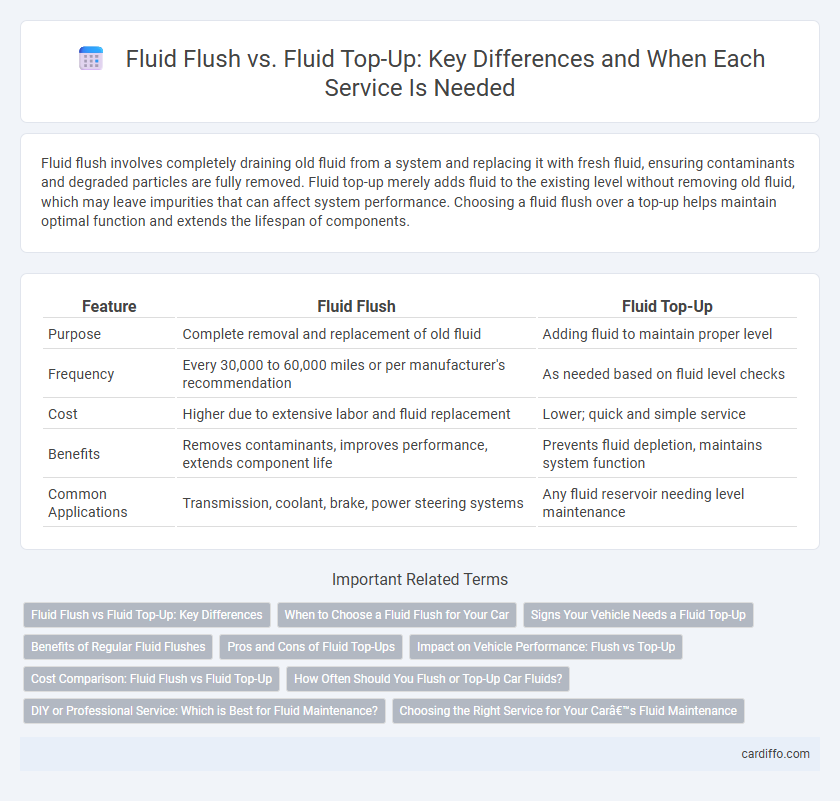Fluid flush involves completely draining old fluid from a system and replacing it with fresh fluid, ensuring contaminants and degraded particles are fully removed. Fluid top-up merely adds fluid to the existing level without removing old fluid, which may leave impurities that can affect system performance. Choosing a fluid flush over a top-up helps maintain optimal function and extends the lifespan of components.
Table of Comparison
| Feature | Fluid Flush | Fluid Top-Up |
|---|---|---|
| Purpose | Complete removal and replacement of old fluid | Adding fluid to maintain proper level |
| Frequency | Every 30,000 to 60,000 miles or per manufacturer's recommendation | As needed based on fluid level checks |
| Cost | Higher due to extensive labor and fluid replacement | Lower; quick and simple service |
| Benefits | Removes contaminants, improves performance, extends component life | Prevents fluid depletion, maintains system function |
| Common Applications | Transmission, coolant, brake, power steering systems | Any fluid reservoir needing level maintenance |
Fluid Flush vs Fluid Top-Up: Key Differences
Fluid flush involves completely draining and replacing old fluid with fresh fluid, ensuring the removal of contaminants and degraded additives that can impair system performance. Fluid top-up merely adds fluid to an existing system without removing old fluid, which may lead to diluted fluid quality and ineffective lubrication or cooling. Choosing fluid flush over top-up extends component lifespan, enhances system efficiency, and prevents potential failures caused by accumulated sludge or degraded fluid.
When to Choose a Fluid Flush for Your Car
A fluid flush is essential when your vehicle's transmission or coolant system exhibits signs of contamination, such as discoloration, foul odor, or degraded performance, indicating old or mixed fluids that can harm engine components. Unlike a fluid top-up, which merely replenishes missing fluid levels, a flush removes sludge, rust, and mineral deposits, restoring optimal system function and preventing costly repairs. Choose a fluid flush during major service intervals or when diagnostics reveal fluid degradation to maintain engine efficiency and extend the lifespan of critical automotive systems.
Signs Your Vehicle Needs a Fluid Top-Up
Low fluid levels can cause warning lights on the dashboard, such as the oil or coolant indicator, signaling the need for a fluid top-up. Noticeable changes in vehicle performance like overheating, unusual engine noises, or sluggish braking response often indicate fluid depletion. Regular checks revealing fluid levels below manufacturer-recommended thresholds confirm that a fluid top-up is necessary to maintain optimal vehicle function.
Benefits of Regular Fluid Flushes
Regular fluid flushes ensure the complete removal of contaminated and degraded fluids, preventing corrosion and buildup in the system. This process enhances the efficiency and longevity of vehicle components by maintaining optimal lubrication and cooling performance. Compared to fluid top-ups, flushes provide a more thorough maintenance solution, reducing the risk of costly repairs and improving overall engine reliability.
Pros and Cons of Fluid Top-Ups
Fluid top-ups offer a quick and cost-effective solution for maintaining optimal fluid levels in a vehicle, preventing potential engine damage due to low fluid. However, top-ups may not address underlying issues like contaminated or degraded fluid, leading to decreased system performance over time. Regular fluid flushes are recommended to ensure thorough cleaning and replacement, but fluid top-ups remain a convenient option for immediate maintenance needs.
Impact on Vehicle Performance: Flush vs Top-Up
Fluid flush thoroughly removes contaminants and degraded fluid from the vehicle's system, significantly improving lubrication efficiency and reducing engine wear for enhanced overall performance. In contrast, fluid top-up merely replenishes lost fluid without addressing underlying contamination, potentially leading to reduced protection and accelerated component deterioration. Regular fluid flushes maintain optimal system function and prolong vehicle lifespan, while relying solely on top-ups may compromise performance and increase maintenance costs.
Cost Comparison: Fluid Flush vs Fluid Top-Up
Fluid flush services typically cost more than fluid top-ups due to the comprehensive cleaning and replacement process involved, often ranging between $100 and $250 depending on the vehicle and type of fluid. Fluid top-ups are more affordable, usually priced between $20 and $50, as they simply replenish the existing fluid without system flushing. Choosing a fluid flush can prevent long-term damage and costly repairs, potentially saving money over time despite the higher upfront cost compared to a basic fluid top-up.
How Often Should You Flush or Top-Up Car Fluids?
Car fluid flush intervals vary by type, typically every 30,000 to 60,000 miles for coolant and transmission fluids, while brake fluid flushes are recommended every 2 to 3 years. Fluid top-ups, such as engine oil or windshield washer fluid, should be checked monthly and topped up as needed to maintain optimal vehicle performance. Regular maintenance based on manufacturer guidelines ensures system efficiency and prevents costly repairs.
DIY or Professional Service: Which is Best for Fluid Maintenance?
Fluid flush involves completely draining and replacing all old fluids, ensuring contaminants and sludge are removed, which is essential for maintaining optimal system performance. Fluid top-up merely replenishes lost fluid without addressing underlying contamination, making it a quick but less thorough option suitable for minor maintenance or emergencies. Professional service is recommended for fluid flush due to the precise equipment and expertise required, while DIY top-ups can be effective for routine checks and small fluid losses.
Choosing the Right Service for Your Car’s Fluid Maintenance
Fluid flush completely replaces old fluid, removing contaminants and ensuring optimal system performance, while fluid top-up only adds missing fluid without addressing potential buildup. Choosing fluid flush is ideal for vehicles with high mileage or when system cleanliness is prioritized, whereas fluid top-up suits routine maintenance and minor fluid level corrections. Assessing your car's service history and manufacturer recommendations helps determine the appropriate fluid maintenance service.
Fluid flush vs Fluid top-up Infographic

 cardiffo.com
cardiffo.com